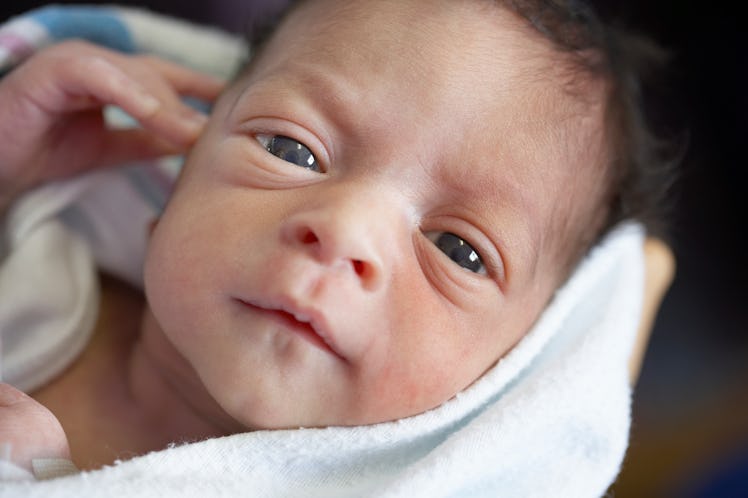Do Baby Boys And Girls Look Different?
Studies suggest you'll guess to baby’s sex correctly 60% of the time, even without social or wardrobe-related cues.

I have no idea whether my newborn daughter “objectively” looks like a girl. We dress her in pink, she often sports a classy elastic bow in her wispy hair, and I’ve changed her diaper a thousand times — so I’m biased. But let’s take away the backstory and the gendered clothing and ignore the spoiler for a second. Would I guess that she’s a girl if I just saw her face? Is it really possible to tell the difference between assigned male and female babies from their faces alone?
The scientific answer, as it turns out, is yes. But only if you try really, really, really hard and get a bit lucky. In other words, my daughter does look like a girl, but only a very little bit.
There are really only three studies you need to know about if you happen to be looking into neonate sex categorization. There’s Richard Porter’s 1984 offering — the first study to explore this question — which concluded that a small sample of adults shown photos of baby faces were about 60% accurate in guessing the child’s sex (which may not sound impressive, but that’s slightly better than random guessing). And there’s the playful 2002 contribution to The British Medical Journal, which surveyed a handful of nurses working a maternity ward and found that they were better than random adults (and doctors) at guessing a baby’s sex from their face.
But the finest study on the subject appeared in the journal Attention, Perception, and Psychophysics in 2011. Researchers selected 120 Caucasian baby faces (along with some adult faces, to act as controls), cropped them carefully, and presented them in black-and-white to 76 adults. Participants managed to categorize the sex of the faces accurately more than half the time, confirming previous findings and suggesting that — if we try hard enough — we probably can tell boy babies from girl babies even without external hints like pink onesies and elastic bows.
Here, try one trial yourself. The adults should be easy to identify. The newborns, less so:
Spoiler: (a)(c) are both female. (b)(d) are both male.
Adult faces are easy because, after puberty, male and female faces embark on divergent paths toward adulthood and we become very good at detecting their subtle differences. Studies have shown that adults can categorize a random person’s sex from looking at their noses, eyes, or eyebrows. That’s probably an evolutionary boon — in the hunt for a suitable mate, the last thing an animal needs is to be confused about which sex it’s pursuing.
Children are trickier to read, though, and newborns even more so. Prepubescent faces have not yet been on the receiving end of the hormones that alter faces, and all newborns kind of just look round, fat, and genderless. Yet, the aforementioned three studies all suggest that we can tell the difference between assigned male and female baby faces. Scientists aren’t sure how we do it.
One possibility is that it all comes down to the baby’s hairiness. In the 2002 BMJ study, researchers asked participants to rate each infant’s hairiness, delicateness of features, coarseness of features, and chubbiness, to see whether any of those intangibles entered into the calculation. One surprising, albeit weak, correlation emerged. Although the baby girls in the sample were no hairier than the baby boys, participants consistently guessed that they were. In fact, 83% of observers correctly guessed that the least hairy baby was male. And when one particularly non-hairy female was shown to participants, only 15% guessed that she was female.
So does my daughter look objectively female? Maybe. She certainly has a nice mop of hair, and I feel fairly confident that she’d look like a girl even in a digital, black-and-white, cropped photo. The science suggests that more than half of all random strangers would probably agree.
This article was originally published on